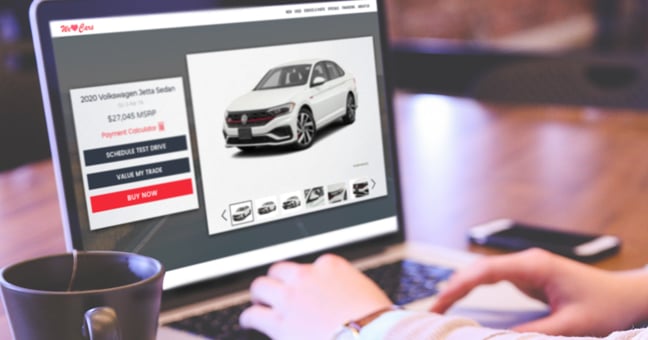

Aug 25 2020
While e-commerce has taken the retail industry by storm, there are a few businesses, including dealerships, that have been reluctant to embrace an e-commerce (or digital retailing) business model. Rightfully so. Purchasing a vehicle is a big decision, and many consumers would still prefer to complete some of the steps at the physical dealership, such as test drives and financing.
Given the COVID-19 situation, many dealers who were relying primary on the traditional in-person dealership experience have worked swiftly to support a fully digital experience – from research to purchase. There are many benefits of digital retailing that will hopefully carry over as we go back to a “new normal.” One of the greatest benefits is the time savings of fast tracking the buying process.
So how can dealers offer a better shopping and buying experience moving forward? We’ve pulled together some excellent advice from industry-leaders on the subject:
Saving consumers time and making car buying convenient are by far the best ways to improve the car buying experience. Many industry experts discuss this very topic. One article we found particularly interesting was a comparison of two real-life car buying experiences via a dealership and Carvana, showcased on the PureCars blog. Though both experiences were incredibly positive for this gentleman and his wife, he was overwhelmed with how convenient and efficient the Carvana shopping and buying experience was. Even though the dealership had a great atmosphere and great employees, they decided to give Carvana a shot for the second vehicle purchase shortly after, as they couldn’t bare the idea of spending another full day at a dealership.
Key takeaway: Shaving time off the car buying process will drastically improve the overall experience
Another common issue that’s been discussed for years is the disconnect between the online and offline experience. Digital retailing still makes up a small percentage of vehicle buyers. The majority of consumers will take a hybrid approach, shopping for a vehicle online and visiting a dealership for the final steps of test driving and purchasing. The two phases of the buying process should be seamless, unfortunately, that is often not the case.
Jazel Automotive wrote a helpful article with 9 ways to blend the online and offline automotive customer experience.
Key takeaway: Evaluate the offline annoyances and see if some of them can be improved or mitigated with online tools or processes. This will allow consumers to get the ball rolling at the dealership much quicker.
Vehicle shoppers do not like a cookie cutter approach. Each shopper has different vehicle needs and doesn’t want to feel pressured into compromising for a vehicle that doesn’t meet those needs. Personalization is important both online and offline.
According to a recent Affinitiv study, “While 65% of consumers want websites to personalize vehicles of interest, only 47% of dealer websites proactively recommend vehicles of interest based on the customer’s browsing behavior.”
Key takeaway: Offer online vehicle research tools that recommend vehicles based on key criteria identified by your potential buyers. These tools should also be made available on the dealer lot. Additionally, giving your sales team access to this information will help provide a seamless experience and allow the sales personnel to make relevant recommendations. Here’s an article by automotiveMastermind with great resources to achieve this.
Today’s consumers are shifting away from the traditional means of communication (phone calls and emails) and moving toward messaging, either texts or chat. Dealerships should support all methods of communication, as many do already.
TrueCar has written an article (view here) on the challenges of communicating via phone in today’s climate, as well as some pointers for more effective communication.
Key takeaway: Allow consumers to communicate with your dealership however they prefer. Sticking to traditional phone calls and emails may put your dealership in a box.
Some of the most time-consuming steps of the car buying process are those involved in the F&I department. In fact, many consumers have obtained outside financing to expedite this part of the process. As such, they are less prone to accept some of the other F&I offerings, such as gap insurance and extended warranties, which are largely important for dealership profitability.
AutoFi, a digital retailing platform, has a number of blog articles on the topic of digitalizing F&I to support the need for a more efficient and convenient financing. Here’s an interesting article on how to handle F&I through remote sales.
Key takeaway: There isn’t a one-size-fits-all digital solution for F&I. Each dealership will want to look into their options and determine which method will work best for them. You will likely want to offer both digital and in-person F&I options to meet the needs of your diverse customer base.
Vehicle video walkarounds, also called virtual tours, have been around for a while now. Since the height of COVID-19, they are more important than ever. According to a recent Google study, there has been a 39% YoY growth in automotive watch time on YouTube, as we as a 127% increase April YoY for the search term “walkaround.”
Sure, these numbers spiked due to stay at home orders, but as we continue to lean on digital resources moving forward, these video walkarounds will be crucial to the online shopping experience.
Key takeaway: Regardless of the current situation, offering online vehicle walkarounds is a great way to get eyes on your dealership and build trust with your potential customers. Video is the primary platform for content now and should be embraced by every dealer.
COVID-19 has not been the ideal situation for the auto industry, especially for dealerships that still require an element of human interaction for the sales and service of vehicles. However, it has certainly played a part in the increasing adoption of a hybrid/fully digital car buying experience.
For those who are looking for ways to improve the dealership experience, especially during this challenging time, many of the solutions mentioned in this article are a great place to start!